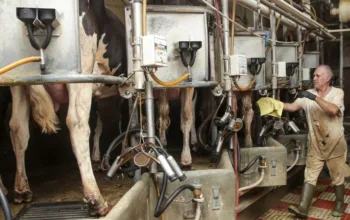Covid transmission continues to ebb and flow — but at least the latest Pirola variant isn’t too menacing.
About six weeks ago, when Americans were in the thick of summer vacation season, Covid-19 alarms began to sound. First, there was a steady uptick in wastewater Covid-19 levels; then a slight increase in hospitalizations.
Then, in mid-August, the World Health Organization announced it was monitoring a new omicron variant called BA.2.86, unofficially named Pirola, due to its high number of mutations. The sheer amount of its genetic distance from its ancestors was deeply concerning to many experts: The variant has about 30 mutations, about the same number that differentiated the highly transmissible and virulent omicron variant from its predecessors.
Experts feared the worst — in particular, that Pirola would be more transmissible and less susceptible to vaccine-induced protection than the variants circulating over the past year and a half.
But over the last few days, several laboratory studies have led to sighs of relief: On a cellular level, Pirola just isn’t that alarming, meaning that the chance this variant will lead to a massive, emergency room-flooding Covid surge is pretty small. Other, less mutated omicron variants remain the dominant strains, and it seems unlikely Pirola will wreak major havoc.
“The good news is, we’re still doing enough sequencing to be detecting new variants before they are widespread,” said Shira Doron, an infectious disease doctor and hospital epidemiologist at Tufts Medical Center in Boston. Also good news: “It is not a foregone conclusion that simply by having 30-plus mutations’ difference, there will be a surge,” she said.
While there may not be a scary new variant on the horizon, Covid-19 transmission is on the uptick, and with it an uncanny (and unwelcome) sense of familiarity.
So what’s the state of Covid-19 today? Let’s take a closer look at the latest Covid-19 variant and the Covid-19 hospitalization situation, as well as at what Covid-19 transmission trends over time can teach us about how the virus spreads.
The current state of Covid infections
It might seem like everyone you know has Covid-19 right now. But on a large scale, it’s hard to tell how many Americans are infected with the virus (much less any of the other circulating respiratory ailments) at any given moment. Even if people do have symptoms, a huge proportion aren’t getting tested, and few home tests are officially counted.
That means the best way to understand Covid-19 trends is to look at hospitalizations and wastewater. Hospitalizations have increased from a low of about 6,000 a week in early July to about 17,000 a week now. Wastewater levels of SARS-CoV-2 have also increased steadily since mid-July.
This all means yes, there’s an increase in cases right now in most parts of the country. But we don’t know how large it is.
Doron sees the uptick in her hospital, where six people are now hospitalized with or for Covid-19. “None of them are in the ICU, but we were ranging zero to three from May until this week,” she said. Although the rise in cases signifies more illness, it doesn’t currently signify a wave of infections that risks straining the health care system.
Pirola, the latest variant, isn’t showing itself to be a major threat
So there’s a real uptick to consider. But what role are emerging variants playing in that uptick?
Right now, the Pirola variant makes up a tiny fraction of the Covid-19 virus that’s currently circulating. As of the CDC’s latest update on August 30, 24 cases had been identified globally, only three of which were in the US.
Furthermore, a shower of data over the last week has shown Pirola to have few characteristics of a concerning variant. Last Friday, a team of scientists in Beijing posted data showing Pirola is less good at invading and infecting cells than other currently circulating omicron variants. And over the weekend, two different labs (one in the US and one in Sweden) shared data showing that neutralizing antibodies trained on older Covid-19 variants were still pretty good at taking Pirola down.
“BA.2.86? Not that scary,” said Doron. “[It seemed] more scary before I got some of that reassuring data.”
What this data says to her and to other experts is that Pirola’s many mutations signify a weaker variant, not a stronger one — that this variant will be harder to spread than its predecessors, and just as susceptible to vaccines.
These findings, especially in the context of the fear that preceded them, are instructive, said Doron. “It’s a good lesson for the future. Not every massively mutated variant is necessarily going to cause a big problem,” she said.
It’s also a reminder that signals from the real world are critical for making sense of laboratory data, said Doron — and in this case, for showing how much less worrisome Pirola is than omicron was.
“When the alarm bells were raised about omicron, it wasn’t just, ‘Here’s a strain with a lot of mutations,’ it was, ‘Here’s a strain with a lot of mutations in South Africa with an extremely rapidly increasing rate of cases, hospitalizations, and deaths,’” she said. “And that’s not what we’re seeing.”
Older Covid-19 variants are likely driving hospitalizations, and the reformulated vaccine is well-positioned to smack them down
The Covid-19 virus is constantly changing, with new variants waxing and waning every few weeks to months.
Right now, the dominant strains of SARS-CoV-2 in the US are all related to the omicron variant, and in particular, a branch of its family tree called XBB. One of these variants, called EG.5 (unofficially dubbed Eris) has been on a slow rise. It now accounts for about one-fifth of cases, while a grab bag of other omicron-related variants (many of them in the XBB group, which have not been associated with big waves of severe illness) make up the rest. Pirola, which is distinct from XBB variants, makes up less than 1 percent of circulating strains.
Yes, there’s been a recent uptick in Covid-19 hospitalizations and deaths — in the past week, they’ve risen 16 and 18 percent, respectively. But that increase is being driven by older XBB variants, not by Pirola, according to the CDC. The good news here is that those XBB variants causing hospitalizations are similar to the ones targeted by the new Covid vaccines expected to roll out in mid-September.
All of that means the new vaccine version will be a good match for the Covid-19 strain most likely to infect people. So if a high proportion of high-risk people get that new vaccine, it’s likely to do a pretty good job at preventing hospitalizations.
Covid peaks and recedes on a different schedule than some other important respiratory viruses
If you notice that Covid transmission is constantly ebbing and flowing, you’re not alone: Experts see this, too. Unlike other respiratory viruses like the flu and RSV, which have seasonal patterns, Covid rates seem to be oscillating constantly.
“Right now, it does not appear like we are settling into any seasonality with Covid,” said Gigi Gronvall, an immunologist and senior scholar at the Johns Hopkins Center for Health Security.
It’s not entirely clear why.
Many respiratory viruses’ seasonality — meaning their fairly reliable rise in transmission during the fall and winter, and drop throughout the summer — is thought to be a product of environmental factors like temperature and humidity, and human behaviors like gathering indoors.
But Covid-19 oscillates more quickly, with cases rising and falling every few months. Peaks in weekly Covid-19 hospital admissions took place four months apart in 2021, six months apart in 2022, and this year, seven months apart.
Doron thinks it’s probably population immunity that drives changes in Covid-19 transmission more than weather or human factors. “Every low is going to be followed by an uptick because that’s a low during which people weren’t getting infected, and population immunity is waning,” she said. Gronvall agreed: “I think it’s really just, there are susceptible people and there’s an infectious virus.”
It doesn’t seem to these experts that human behavior — like wearing or not wearing masks, or social distancing — is entirely responsible for the timing of these reoccurring upticks. These days, people aren’t really switching back and forth between “taking precautions, letting their guard down, taking precautions, letting their guard down,” said Doron; most seem to permanently have their guard down. Indeed, a June poll suggested public concern about Covid-19 was near an all-time low, with only 18 percent of Americans expressing worry about getting infected.
Furthermore, if human behavior were the main factor responsible for all respiratory virus’s transmission trends, we’d see all of these viruses peak when, say, weather drives people indoors — and that’s not happening, said Gronvall. In reality, some viruses stubbornly retain a yearly peak-and-fall pattern (even after a pandemic-related shake-up), while others wax and wane more idiosyncratically.
Yes, our actions play some role in determining the spread of respiratory illness. But in a world where unmasked social mixing is the norm, rising and falling immunity to certain viruses may be playing a bigger part than previously realized in driving transmission of those viruses.
How to protect yourself (and others) this fall
The current Covid outlook and new data on seasonality suggest there’s no need to return to the hypervigilant state of early pandemic times.
But it still makes sense to protect ourselves and those around us from unnecessary illness. That’s especially true for people at high risk of severe illness, but it’s also true for otherwise healthy folks, especially given the unpredictable risk of long Covid symptoms following infection (which vaccines and Paxlovid treatment lower).
That means it’s a good idea for everyone eligible for the newly formulated Covid-19 vaccination to get one when it becomes available later this month. It also means health care providers and patients should advocate for early treatment with highly effective antiviral medications like Paxlovid. Although the drug is proven to save lives in high-risk people infected with Covid-19, “a lot of people are not getting prescribed Paxlovid because of misconceptions about what it does,” said Gronvall.
And you can choose to switch between taking precautions (like wearing a mask in public) and letting your guard down as often as you like, regardless of what everyone else is doing. Covid-19 is with us for the foreseeable future, and as it continues to evolve, our strategies to cope with it should, too.



